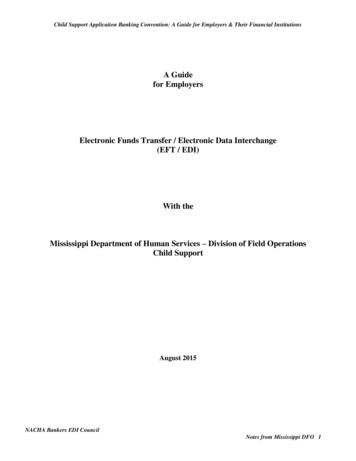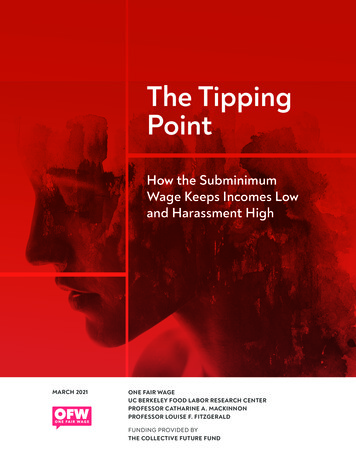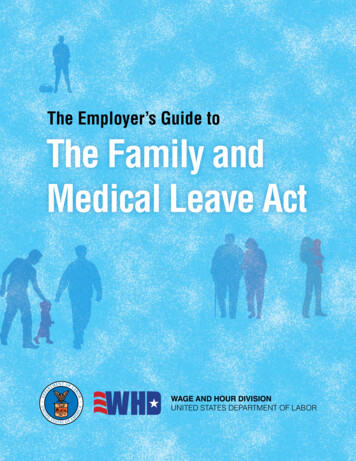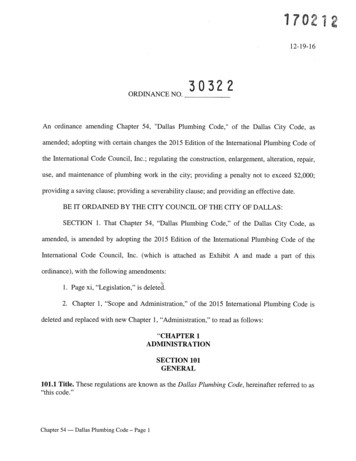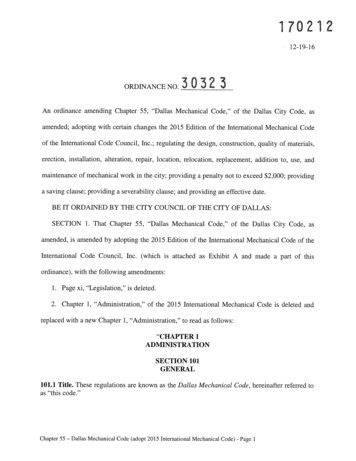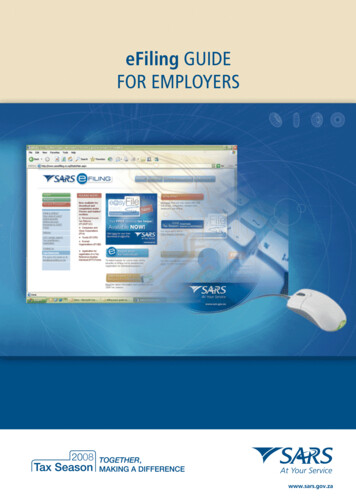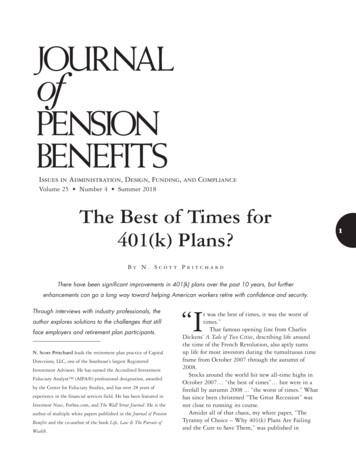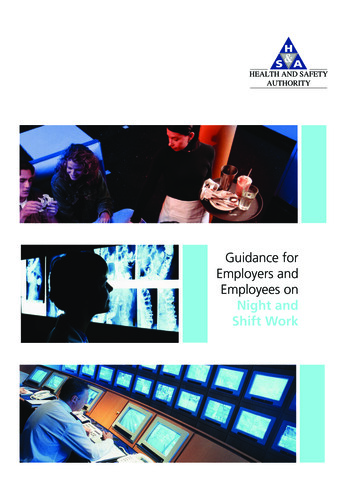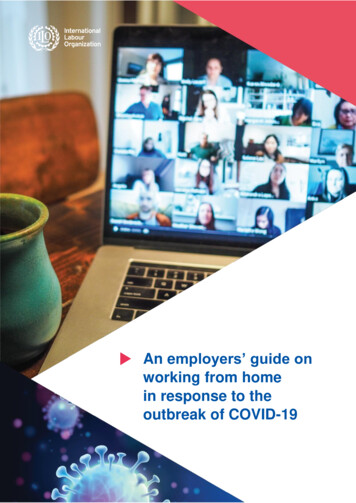
Transcription
0An employers’ guide on working from home in response to the outbreak of COVID-19An employers’ guide onworking from homein response to theoutbreak of COVID-19
An employers’ guide on working from home in response to the outbreak of COVID-191Copyright International Labour Organization 2020First published 2020This is an open access work distributed under the Creative Commons Attribution 4.0 InternationalLicense (https://creativecommons.org/licenses/by/4.0/). Users can reuse, share, adapt and build uponthe original work, as detailed in the License. The ILO must be clearly credited as the owner of theoriginal work. The use of the emblem of the ILO is not permitted in connection with users’ work.Translations – In case of a translation of this work, the following disclaimer must be added along withthe attribution: This translation was not created by the International Labour Office (ILO) and should notbe considered an official ILO translation. The ILO is not responsible for the content or accuracy of thistranslation.Adaptations – In case of an adaptation of this work, the following disclaimer must be added along withthe attribution: This is an adaptation of an original work by the International Labour Office (ILO).Responsibility for the views and opinions expressed in the adaptation rests solely with the author orauthors of the adaptation and are not endorsed by the ILO.An employers' guide on working from home in response to the outbreak of COVID-19Geneva: International Labour Office, 2020ISBN 9789220322536 (web PDF)Also available in French: ISBN 9789220322604 (web PDF) and Spanish: ISBN 9789220322611 (webPDF)The designations employed in ILO publications, which are in conformity with United Nations practice,and the presentation of material therein do not imply the expression of any opinion whatsoever on thepart of the International Labour Office concerning the legal status of any country, area or territory or ofits authorities, or concerning the delimitation of its frontiers.The responsibility for opinions expressed in signed articles, studies and other contributions rests solelywith their authors, and publication does not constitute an endorsement by the International LabourOffice of the opinions expressed in them.Reference to names of firms and commercial products and processes does not imply theirendorsement by the International Labour Office, and any failure to mention a particular firm, commercialproduct or process is not a sign of disapproval.Information on ILO publications and digital products can be found at: www.ilo.org/publns.
2An employers’ guide on working from home in response to the outbreak of COVID-19How to use this guideThis guide has been developed by the [NAME OF EBMO] in collaboration with the International LabourOrganization Bureau for Employers’ Activities (ILO-ACT/EMP) to provide practical guidance to membercompanies that have implemented “working from home” protocols for their staff in 2020 as analternative temporary arrangement during the COVID-19 crisis.Companies have implemented working from home protocols as preventive measures or in responseto the order or directive of the Government restricting face-to-face contact. This guide providesrecommendations for companies, including the duties and responsibilities of employers and workers,considerations and challenges, and how to address and manage those challenges. It also provides asample template for companies to enable them to develop a bespoke working from home policy.This guide makes reference to international labour standards laid down in relevant conventions andrecommendations. These standards are internationally negotiated and adopted by governments,employers and workers in the ILO and form the basis for many national labour laws.AcknowledgementsJae-Hee Chang, Maria Machailo-Ellis and Gary Rynhart led the development of this guide from ILOACT/EMP. It was reviewed by Samuel Asfaha, Magdalena Bober, Farid Hegazy and Vanessa Phalafrom ILO-ACT/EMP. Jon Messenger and Valentina Beghini from the ILO’s Conditions of Work andEquality Department also provided valuable inputs and comments. Finally, Miaw Tiang Tang draftedthis guide.Disclaimer: The responsibility for opinions expressed in this guide rests solely with their authors, andthe publication does not constitute an endorsement by the International Labour Office of the opinionsand guidance expressed in them. Reference to names of firms and commercial products andprocesses does not imply their endorsement by the International Labour Office.
An employers’ guide on working from home in response to the outbreak of COVID-193Foreword by the PresidentIn only a few months’ time, the coronavirus (COVID-19) pandemic has had a devastating economic,social and health impact across the globe. Hundreds of thousands of lives have already been lost, andthe end of this crisis is not yet in sight. From the outset, [NAME OF EBMO] has been working with ourmembers across the country to assist them in managing the negative economic, social and healthimplications of the COVID-19 crisis.[NAME OF EBMO] will continue to provide support throughout this crisis. Our priorities throughout thecrisis are to: provide strong leadership to ensure the health and sustainability of the workforce and ourcommunities; represent the interests and needs of business in crisis to Government with innovative and quickaction, measures and solutions; support business during this period with relevant information and services as well as opportunitiesfor remote networking and engagement with peers as these alternative arrangements arebecoming universal.This guide is the latest example of our commitment to our members.Employers navigate a complex and evolving landscape. In our daily discussions with governmentrepresentatives, we are prioritizing measures to support business continuity. This is particularly criticalfor the hospitality, retail and related sectors that have already suffered a very significant demand shock.Difficult decisions are being made each day and people’s safety must always come first. We urge ourmembers to implement government measures as speedily and effectively as possible and implementpositive action wherever possible.This guide has been designed to help our members respond to a “new normal” that is changing day byday. Many companies are relying on “working from home” arrangements for the first time. Some arethriving while others are struggling to adapt. I hope this guide can provide timely assistance.Finally, I would like to thank the International Labour Organization for their assistance in developingthis guide.Yours sincerely,President of [NAME OF EBMO]
4An employers’ guide on working from home in response to the outbreak of COVID-19ContentsForeword by the President3Introduction51. What is working from home?52. How is working from home different from teleworking, telecommuting, or remote working?53. Are all jobs suitable for working from home arrangements?64. How are companies adapting to implementing WFH arrangements?75. Are workers obliged to observe the company's directive to work from home?76. What are employers’ responsibilities when implementing working from home arrangementsin response to COVID-19?87. What are workers’ responsibilities when working from home?128. How do you measure workers’ productivity when working from home?139. What are the main challenges in implementing working from home arrangements and whatconsiderations should be made to address and manage them?1410. Should working from home continue after COVID-19?23Annex: Working from home policy template24References30
An employers’ guide on working from home in response to the outbreak of COVID-195IntroductionThe coronavirus (COVID-19) pandemic continues to severely affect public health and causeunprecedented disruptions to economies and labour markets. In line with the advice from the WorldHealth Organization (WHO), many steps have been taken worldwide to contain the spread of the virus.Governments have implemented measures ranging from physical distancing, restrictions on thefreedom of movement and the closure of non-essential companies and undertakings, to the lockdownof entire cities in different parts of the world. As the pandemic evolves, so have the measuresgovernments have taken to address it.Reducing face-to-face contact is an important action to mitigate the impact of COVID-19. According tothe International Labour Organization (ILO), around 68 per cent of the world’s total workforce, including81 per cent of employers, are currently living in countries with recommended or required workplaceclosures.1 In this new environment, employers have to be able to adapt and make contingency plansto respond to new measures as they arise. Many companies are exploring working from home (WFH)as a temporary or alternative working arrangement.1. What is working from home?WFH is a working arrangement in which a worker fulfils the essential responsibilities of his/her job whileremaining at home, using information and communications technology (ICT). For the purpose of thisguide and in the context of the COVID-19 pandemic, the term “working from home” is used to referuniquely to home-based teleworking as a temporary, alternative working arrangement. It requires ashared responsibility and commitment by both employers and workers to ensure business continuityand employment.2. How is working from home different from teleworking, telecommuting, or remoteworking?Progress in ICT has enabled and facilitated alternative working arrangements, including WFH,teleworking, telecommuting and remote working. These terms are often used interchangeably to referto new and evolving models of working outside the employers’ premises or workplace. There may beslight differences among these terminologies. For example, some may imply a temporary arrangementwhile others may imply a long-term arrangement. WFH is considered to be home-based telework2 thedifference being that teleworking may include various locations away from the primary worksite or theemployer’s premises (such as mobile working). 3 Telecommuting refers to substitutingtelecommunications for commuter travel. There are some differences between the terms “teleworking”and “telecommuting”, mainly because telework is broader and may not always be a substitute forcommuting, but they are relatively minor. For the purposes of this guide, the terms “teleworking” and“telecommuting” are used interchangeably.123ILO (International Labour Organization), “ILO Monitor: COVID-19 and the world of work. Third edition – Updated estimates andanalysis”, 29 April 2020.Eurofound (European Foundation for the Improvement of Living and Working Conditions) and ILO, Working anytime, anywhere: Theeffects on the world of work (Luxembourg and Geneva, 2017).Jon C. Messenger (ed.), Telework in the 21st Century, an Evolutionary Perspective, ILO Future of Work series, (Edward Elgar and ILO,2019).
6An employers’ guide on working from home in response to the outbreak of COVID-19EBMO to insert definitions from national legislation or practices on “remote work”,“telework”, “telecommuting” or “work from home” if available.3. Are all jobs suitable for working from home arrangements?When worksites and premises are closed across the entire company as a precautionary measure oras a result of a government directive, companies may be able to implement WFH arrangements toachieve continuity of service, maintain productivity, and preserve jobs while safeguarding the safetyand health of workers. The ILO estimates that close to 18 per cent of workers have occupations thatare suitable for WFH and live in countries with the infrastructure to enable WFH.4The responsibility for WFH arrangements is shared, and it requires the commitment of both employersand workers to make it successful. Both employers and workers should be practical, flexible andsensible to each other's situation when implementing WFH arrangements.Before rolling out WFH arrangements, employers should first assess if it is possible and practical forthe job functions and the jobholder, as follows: Identify the job functions and tasks that can be done off-site. This may involve innovation andcreativity to do things differently from the norm. Assess mechanisms for connectivity such as regular videoconferencing calls and other means. Assess the infrastructure, facilities and tools available for WFH, such as Internet connectivity andthe availability of reliable power supply. Assess the legal requirements, obligations and potential liability, taking into consideration theworker’s situation and the job functions, equipment and tools needed5. Assess the worker’s situation in terms of safety and health in his/her domestic environment andactual ability to carry out the tasks required at home. Consider the potential impact of the worker’s living arrangements. For example, workers may havechild or dependent care responsibilities, relationship strain or domestic violence, long-term healthconditions or disabilities. Assess any mental health concerns or possible future concerns that could arise through a workfrom home arrangement.It is important to note that while advances in ICT have enabled WFH, not all job functions and taskscan be done outside the employers’ premises or the specified workplace. There are companies,occupations and tasks where WFH is not practical or feasible, or it cannot be deployed in a short timeframe.Employers need to explore and implement an alternative plan for job functions and tasks that cannotbe performed remotely, or for workers who have limitations at home or health and safety issues thatprevent WFH. Subject to the provisions in national laws and regulations, government directives orcompany policy, employers may consider advising workers to take accrued or advance paid annualILO, “Working from Home: A potential measure for mitigating the COVID-19 pandemic”, Policy Brief, April 2020.Employers should consider whether the home workspace is insured. Many employer liability policies will encompass WFH arrangements,but this should be verified. Employees may alternatively be covered by their personal home insurance policy.45
An employers’ guide on working from home in response to the outbreak of COVID-197leave, extended leave at half pay or unpaid, or any other applicable leave that could be used in thesituation in consultation with the workers’ concerned.4. How are companies adapting to implementing WFH arrangements?Some companies may have previous experience in implementing WFH arrangements or they mayalready have emergency WFH plans in place. However, many companies are likely to be implementingWFH arrangements for the first time, and they need to quickly and urgently adopt WFH arrangementacross the entire company. For example, a survey conducted in March 2020 of 250 large firms inArgentina found that 93 per cent had adopted teleworking as a policy in response to the COVID-19pandemic. Similarly, the Indian business process outsourcing giant, Tata Consultancy Services,reported that around 85 per cent of its 400,000 employees in India and elsewhere in the world wereworking from home as a result of lockdowns.6Although many companies recognize the benefits of WFH, some have had difficulty making thetransition. In Japan, for example, a survey conducted prior to the 7 April announcement of a state ofemergency, found that while 96 per cent of respondents agreed with the importance of WFH or workingremotely, 31 per cent of companies were unable to adopt this form of working. The main reason wasthat paperwork was not digitized and the required internal rules and procedures for teleworking werenot ready. Concerns over confidentiality of information or possible security breaches can also limit theuse of WFH. Many small and medium-sized enterprises (SMEs) also struggle with WFH, and a numberof recent surveys demonstrate this. The Argentine SME Observatory for example found that SMEs usetelework much less than by large companies.7According to Mercer’s 2020 Global Talent Trends Study, only 22 per cent of companies were ready formass remote working prior to the outbreak of COVID-19. The study also found that only 44 per cent ofcompanies systematically assess jobs for their adaptability rather than allowing flexibility to bedetermined by the worker’s circumstances. Such assessments can help companies design flexibilityinto a job in a systematic manner, balancing the needs of the company and its workers.EBMO to provide data on any national survey if available that shows number of nationalfirms with WFH arrangements. If not, include a quote on WFH by the EBMO President/CEOor major company on the trend of WFH arrangements.Example: “In [NAME OF COUNTRY] working from home is a relatively new experience for manycompanies. In our discussions with our member companies, we have found that many are adaptingto these new realities and are seeing many advantages. However challenges remain for many andwe are fully cognizant of those”.5. Are workers obliged to observe the company's directive to work from home?Normally, WFH arrangements are implemented on a voluntary basis between employers and workers,often accompanied by a signed agreement setting out terms and conditions. In the current situation,however, WFH has been mandated in many parts of the world as a temporary public health measure.67ILO, “Working from Home”.ILO, “Working from Home”. The Argentine SME observatory found the use of telework to be only 55 per cent of SMEs in the service sector,24 per cent of SMEs in industry and 23 per cent of SMEs in retail trade.
8An employers’ guide on working from home in response to the outbreak of COVID-19In accordance with Article 19(a) of the Occupational Safety and Health Convention, 1981 (No. 155),workers are legally obligated to cooperate with the employer to secure a safe and healthy workingenvironment in support of relevant statutory provisions, collective agreements or company policies.Workers are also responsible for taking care of their own health and safety and the safety of others,using devices and protective equipment and complying with the policies set forth by the employer.Additionally, in accordance with Paragraph 16 of the Occupational Safety and Health Recommendation,1981 (No. 164), they should report any hazards or issues as soon as possible following the employer’sreporting procedures. It is important to be clear that the workers’ obligations and responsibilities applyeven in the informal surroundings of WFH arrangements.Therefore, when WFH is required to minimize the spread of a pandemic, workers must cooperate andcomply fully with preventive measures or directives, take reasonable care of their own safety and thesafety of others and observe company policies.86. What are employers’ responsibilities when implementing working from homearrangements in response to COVID-19?It is important to note that temporary WFH arrangements do not require any permanent adjustment tothe terms and conditions of employment. The arrangements can change in response to updateddirectives and the evolving needs of the company. Employers should consider modifying or developinga company policy or guidelines to provide clear guidance on implementing WFH arrangements (seeannex for a template). They should communicate the policy effectively to all workers, and any changesto the policy should be communicated as early as possible.Many countries around the world have begun legislating aspects of WFH/remote workingarrangements, working conditions, the rights and responsibilities of employers and workers. Forexample, in the Netherlands, the Working Conditions Decree concerns paid work performed in theworker’s living quarters or another place chosen by the worker outside of the employer’s premises. Itincludes the employer’s duty of care to check on the worker and ensure legal obligations under theDecree are met. In Poland, the provision of the Labour Code that addresses “telework” emphasisesthat the location of work is away from the premises of the employer and is based on services renderedby electronic means, while in Austria, “telework” is regulated through working-time legislation, ratherthan as a separate issue.9 In March 2020, Chile enacted a law regulating teleworking, granting legalcertainties to both employers and workers in teleworking arrangements and specifying their rights andresponsibilities. For example, employers’ obligation includes bearing the costs of operation, functioning,maintenance and repair of equipment.108910In Singapore, a new COVID-19 (Temporary Measures) (Control Order) Regulations 2020 was passed on 7 April requiring companies toimplement WFH, when possible, and making it an offence if a company does not implement remote working measures if the job scopeallows it.Examples from the Netherlands, Poland and Austria were drawn from: ILO, Ensuring decent working time for the future, General Surveyconcerning working-time instruments, Report III (Part B), Committee of Experts on the Application of Convention and Recommendations,International Labour Conference, 107th Session, (Geneva, 2018) p. 744.Dentons, “Chile Telework law”, April 2020.
An employers’ guide on working from home in response to the outbreak of COVID-199EBMO to insert any general comments on national WFH legislation or a statement from theEBMO President/CEO on “good practice”.Example: “Operationally, managing workers from home is a new experience. In such a situation, itis critical that communication occurs regularly and for communication to be targeted and personal.Managers should be prepared to listen to workers to flush out any customer concerns so workerscan respond correctly. Face-to-face conferencing and virtual team meetings should occurfrequently. Setting up a routine for departments and employees will provide clear expectations andcollaboration. Plan a weekly agenda and distribute it to team members to allow for input before themeetings.”If there is no specific legislation on WFH, employers are advised to consult provisions in existingnational laws and regulations related to labour and employment, occupational safety and health, or therelevant directives and guidelines issued by the respective national and local authorities.Safety and health of workersArticles 3, 16, 18, 19 and 21 of Convention No. 155The term health, in relation to work, indicates not merely the absence of disease or infirmity; it alsoincludes the physical and mental elements affecting health which are directly related to safety andhygiene at work a. Employers have the overall responsibility of ensuring that all practicablepreventive and protective measures are taken to minimize occupational risks, b and that includesproviding, where necessary and so far as is reasonably practicable, adequate protective clothingand protective equipment, at no cost to the worker.c Employers are also responsible for providingadequate information and appropriate training on OSH [occupational safety and health];dconsulting workers on OSH aspects associated with their work;e and providing measures to dealwith emergencies.fabcdefeArticle 3(e)Art. 16 of Convention No. 155 provides that “Employers shall be required to ensure that, so far as is reasonably practicable,the workplaces [ ] under their control are safe and without risk to health.”Articles 16(3) and 21.Article 19(c) and (d).Article 19(e).Article 18.Article 18.Employers have a duty of care for all their workers and need to, insofar as it is reasonably practicable,provide a working environment that is safe and without risks to physical and mental health. Thisincludes assessing, controlling and mitigating risks in locations other than the normal workplace, suchas the worker’s home during WFH. Employers should also remind workers of their duties andobligations under their contracts of employment and applicable policies, in particular, their obligationsand duties in relation to health and safety.Even though it may be difficult for employers to carry out traditional health and safety risk assessmentsat a worker’s home in the current context, it remains the employers’ responsibility to check that: the work asked to be performed is one that can be safely performed from home; adjustments are made to the tasks, if needed, to ensure that they are safely doable when WFH;
10 An employers’ guide on working from home in response to the outbreak of COVID-19 workers have the right equipment and tools to work safely at home, including the requiredprotective or safety equipment, where applicable; arrangements are made to ensure the company’s equipment, if taken home to facilitate WFH, isaccounted for and returned in the condition it was provided; workers have relevant information, instruction, supervision and training, including measures to dealwith emergencies; reasonable accommodations are made for workers with disabilities in relation to the work they arerequired to perform from home; arrangements are made for workers’ physical and mental welfare;To facilitate WFH during COVID-19, Spain established an exceptional temporary legal measureallowing WFH risk assessments to be carried out by the worker based on a provided checklist11.EBMO to insert relevant national OSH legislation that would cover WFH arrangements.Employers should establish a system for reporting and investigating injuries, illness or other accidentsthat occur because of work activities. Additionally, employers should be aware of any increased healthand safety risk that may arise from WFH during the COVID-19 pandemic. This could include heightenedpsychosocial hazards connected to WFH, including a potential rise in occupational stress. It couldfurther encompass increased odds for an incident of domestic violence to occur due to economichardship and changed family demands at the household level and forced confinement to the home.There are reports in some countries of increased domestic violence and abuse during COVID-19lockdowns.12 Employers should keep in regular contact with their workers and keep them apprised ofany resources they may have. For example, some employers maintain employee assistanceprogrammes that provide for confidential counselling and referral services.13Tools, equipment, supplies, and technologyEmployers should provide workers the specific tools, equipment, supplies, and technology needed forperforming the required tasks when implementing WFH arrangements unless the terms and conditionsof employment, collective agreement, or company policy state otherwise. 14 Additionally, employersshould see to the repair of such tools and equipment if necessary. The type of equipment and set-uprequired depends on the business and work involved. This may include a laptop, computer monitors,software, phone, access to the Internet, headset, access to host applications, and other applicableequipment as deemed necessary. In other situations, it may include the delivery of equipment and theinstallation of technical devices required for the job.Employers could consider setting up a separate help desk or support email address where workerscan forward issues related to workplace tools, equipment and technology to seek help and support11121314ECIJA, COVID-19 Spain: FAQs for business.The News International reported that in China's Hubei Province, police reports on domestic violence tripled during the coronavirusoutbreak. In Brazil, state-run drop-in centres recorded a 40 per cent surge in cases attributed to COVID-19 isolation.Employers can also provide information about national or local programmes established to support victims of domestic violence.ILO, Final report: Global Dialogue Forum on the Challenges and Opportunities of Teleworking for Workers and Employers in the ICTSand Financial Services Sectors, GDFTWEFS/2016/9, p. 28. "Employers should unless there is an agreement to the contrary with theworker, shoulder the hardware and software costs.”
An employers’ guide on working from home in response to the outbreak of COVID-1911when needed. Employers should also make clear that the use of equipment and tools provided by thecompany for WFH is limited to the worker only and for work performance only.Home working setup and related expensesWFH expenses traditionally are not reimbursable under most national laws and practices. However, inthe current pandemic situation, WFH may be necessary and result in workers incurring relatedexpenses. In the absence of legislative requirements or government directives requiring employers toreimburse workers for WFH expenses, employers should consider reimbursing workers for theirreasonable and necessary home office expenses incurred in performing required tasks. This mayinclude a portion of the expenses associated with: mobile phone or landline costs Internet costs personal computer or tablet teleconferencing software or hardwareHowever, employers may exclude home office expenses which are mainly for the convenience of theworker, which may include a faster Internet connection, additional computer monitors, ergonomicchairs, or printers.15 Employers should ensure the company policy specifies which expenses it willcover for WFH situations. The policy could specify that workers must seek the company’s prior approvalfor the reimbursement for expenses incurred in WFH situations.Worker’s compensationGenerally, in some countries, when WFH is implemented, any injury incurred during work hours andarising from or while performing work functions in the designated work area of the house may becovered by worker’s compensation insurance. In other countries however, employment injuryinsurance may not foresee the coverage of WFH arrangements. This would depend on national lawsand judicial precedents.Overall the number of workers’ compensation claims could fall during the pandemic, as fewer peopleare working. But that effect
An employers' guide on working from home in response to the outbreak of COVID-19 3 Foreword by the President In only a few months' time, the coronavirus (COVID-19) pandemic has had a devastating economic, social and health impact across the globe. Hundreds of thousands of lives have already been lost, and
